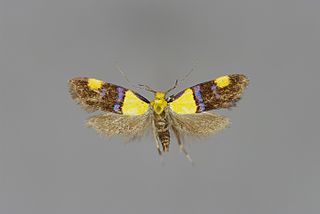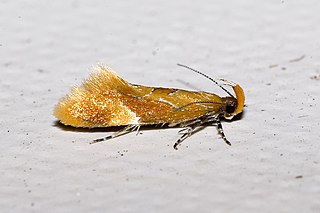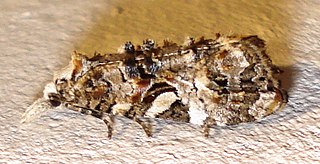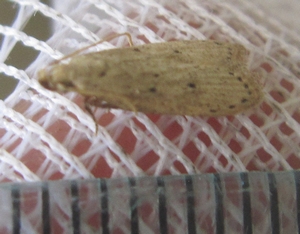
The white-shouldered house moth is a species of gelechioid moth. It belongs to the subfamily Oecophorinae of the concealer moth family (Oecophoridae), just like the brown house moth. Though several presumed congeners of E. sarcitrella were described, its genus Endrosis is currently understood to be monotypic.

Ephestia elutella, the cacao moth, tobacco moth or warehouse moth, is a small moth of the family Pyralidae. It is probably native to Europe, but has been transported widely, even to Australia. A subspecies is E. e. pterogrisella.

Olethreutes arcuella, the arched marble, is a colorful small moth species of the family Tortricidae.

Dolicharthria punctalis, the long-legged china-mark, is a species of moth of the family Crambidae. It is the type species of the proposed genus Stenia, which is usually included in Dolicharthria but may be distinct.

Monopis obviella is a species of tineoid moth. It belongs to the fungus moth family (Tineidae), and therein to the nominate subfamily Tineinae. It is the type species of Blabophanes, today treated as a junior synonym of the genus Monopis. M. crocicapitella was only separated from the present species in 1859, and is still frequently confused with it even by rather recent sources.

The brown-dotted clothes moth is a species of tineoid moth. It belongs to the fungus moth family (Tineidae), and therein to the nominate subfamily Tineinae. It is the type species of its genus Niditinea.

Oecophora bractella is a species of gelechioid moth. It belongs to the subfamily Oecophorinae of the concealer moth family (Oecophoridae). As the type species of its genus Oecophora, its affiliations and phylogeny determine the delimitation of that family and subfamily.

Pseudatemelia flavifrontella is a species of gelechioid moths.
Pseudatemelia subochreella is a species of gelechioid moths. Here, it is placed within the subfamily Amphisbatinae of the concealer moth family (Oecophoridae). The Amphisbatinae have alternatively been merged into the Oecophorinae, raised to full family rank, or placed as a subgroup of the Depressariinae.

Aglossa caprealis, the stored grain moth, is a moth species of the family Pyralidae. It is found globally, though its native range is presumably western Eurasia or nearby regions, as in other Aglossa species.

Epicallima formosella is a species of gelechioid moth. It belongs to subfamily Oecophorinae of the concealer moth family (Oecophoridae).

Cnephasia asseclana, the flax tortrix, is a moth of the family Tortricidae. It is found all over Europe.

Celypha aurofasciana is a small moth species of the family Tortricidae. It is native to Europe and the Palearctic but occurs in some other places as an introduced species.

Phtheochroa rugosana is a small moth of the family Tortricidae.

Cydia illutana is a small moth of the family Tortricidae. It is found from western and central Europe, north to Scandinavia and east to Russia (Siberia).

Aglossa is a genus of small moths belonging to the family Pyralidae. It was described by Pierre André Latreille in 1796. They are found mainly in western Eurasia, though some species have been introduced elsewhere.
Schiffermuelleria is a genus of gelechioid moths. It is placed in the subfamily Oecophorinae of family Oecophoridae. The genus is treated as monotypic, with the single species Schiffermuelleria schaefferella placed here. As such, its distinctness from the closely related genus Borkhausenia – where S. schaefferella was often placed in the past – is open to debate.

The Galleriinae are a subfamily of snout moths and occur essentially worldwide, in some cases aided by involuntary introduction by humans. This subfamily includes the wax moths, whose caterpillars (waxworms) are bred on a commercial scale as food for pets and as fishing bait; in the wild, these and other species of Galleriinae may also be harmful to humans as pests.

Corcyra is a genus of snout moths. It was described by Ragonot in 1885, and is known from China, Great Britain, Australia, and Egypt.

Hypsopygia glaucinalis is a moth of the family Pyralidae. It is sometimes placed in the genus Orthopygia either alone or with a few other species. Being the type species of Orthopygia, as soon as O. glaucinalis is placed in Ocrasa"Orthopygia" is abolished. To further complicate matters, Ocrasa is now mostly treated as a synonym or subgenus of Hypsopygia.



















